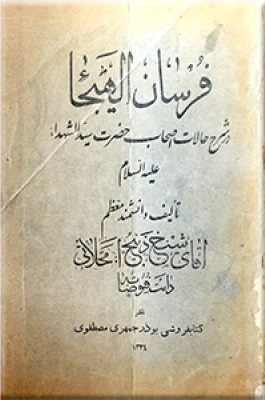Fursan al-Hayja: Difference between revisions
(Created page with "{{Infobox book | name = Fursan al-Hayja | image = Fursan al-Hayja.jpg | caption = | alt = | author = Zabihullah Mahalati | title_orig =فُرْسانُ الْهَیْجاء | orig_lang_code = | title_working = | illustrator = | cover_artist = | language = Farsi & Arabic | series = | subject =martyrs of Karbala | genre = | published = | publisher = | media_type = | pages = | awards = | preceded_by = | followed_by = | wikisource = | fulltext = | En_title = | tr...") |
No edit summary |
||
| (One intermediate revision by the same user not shown) | |||
| Line 11: | Line 11: | ||
| cover_artist = | | cover_artist = | ||
| language = Farsi & Arabic | | language = Farsi & Arabic | ||
| series = | | series =2 Vol | ||
| subject =martyrs of Karbala | | subject =Biography of martyrs of Karbala | ||
| genre = | | genre = | ||
| published = | | published = | ||
| Line 53: | Line 53: | ||
[[Category:Works]] | [[Category:Works]] | ||
[[Category:Ancient Books]] | [[Category:Ancient Books]] | ||
[[fa:فرسان الهیجاء (کتاب)]] | |||
Latest revision as of 11:46, 25 October 2022
 | |
| Author | Zabihullah Mahalati |
|---|---|
| Original title | فُرْسانُ الْهَیْجاء |
| Language | Farsi & Arabic |
| Series | 2 Vol |
| Subject | Biography of martyrs of Karbala |
Fursan al-Hayja (Persian: Savaran-e-Nabard; Arabic: فُرْسانُ الْهَیْجاء), written by Zabihullah Mahalati, introduces 230 companions of Imam Hussain in the event of Ashura in two volumes. The original book is in Arabic, later translated into Persian by the author, but now the Arabic version is unavailable.
About the author[edit | edit source]
Zabihullah Mushtaq Askari, known as Zabihullah Mahalati (1366-1271 SH), is a Shia cleric and writer. He learned his introductory lessons in Mahalat and then received permission to narrate from Seyyedaboulhasan Esfahani and Mirzahasan Naini.[1] Many books are left from Mahalati: Rayahin al-Sharia, Qurat al-Ain, Akhtaran Tabnak, Forsan Al-Hayja, etc. He was buried in 1366 SH in Bayn al-Ḥaramayn (between two shrines) of Abd al-Azim al-Hasani.[2]
About the book[edit | edit source]
In the book Forsan Al-Hayja, the author narrates the description of 230 companions of Imam Hussain in Karbala and after the Ashura incident in Basra and Kufa in alphabetical order. The book is written in two volumes. In the first volume, the author introduces 140 of the Imam's companions,[3] starting from "Alif to Ayin", that is, from "Abu Thumama al-Sa'idi" to "Ammar bin Hasan Tai" and in the second volume, 90 other companions from "Ayin to Yodh", that is, from "Ammar b. Abi Salama" Hamdani" to "Yazid Ibn Mohajer". In the biography book, the author explains their names and ancestry and how they were martyred. At the end of the book, the uprising of Mukhtar and the fate of the killers of Imam Hussein are discussed.
Forsan Al-Hayja was initially written in Arabic and later translated into Persian by the author, although the Arabic version is unavailable.[4] In 1386 SH, Mohammad Shuaa Fakhir translated its Persian text into Arabic under the name "Forsan al- Hayja fi Tarajam Ashab Sayyid al-Shuhada".[5] The writing of the first volume was finished in 1348 AH and was published during the author's lifetime by Bouzarjamhari Publications.[6] Of course, other editions of the book are also available.
The value and importance of the book[edit | edit source]
The author of Forsan Al-Hayja has used new and old books to confirm the accuracy of his content in the martyrs' biography, mentioning the book's title and the page number in the footnote. The prose of the book is simple and uncomplicated. One of the objections to it is that the names of Imam Hussain's companions often do not match the names mentioned in the authentic Maqtals. Mohammad Esfandiari believes that the author has not checked the correctness or incorrectness of some information; for example, he named people who were not martyrs among the martyrs, or he mentioned the name of one person twice, thinking that it was the name of two people.[7]
Sources[edit | edit source]
- Daneshname Eslami (Islamic encyclopedia)
- Mojahidi, Mohammad Ali, Pazhuheshi Dar Maqhtalhay-e- Farsi (research on Persian Maqtals), pp. 191 and 192.
- Esfandiari, Mohammad, Ketabshenasi-e- Tarikhi-e- Emam Hussein (historical bibliography of Imam Hussein (p.b.u.h) p. 165.
- News of the Islamic Republic of Iran.
References[edit | edit source]
- ↑ Daneshname Eslami (Islamic encyclopedia)
- ↑ News of the Islamic Republic of Iran
- ↑ Esfandiari, Mohammad, Ketabshenasi-e- Tarikhi-e- Emam Hussain (historical bibliography of Imam Hussain) p. 165.
- ↑ Esfandiari, Mohammad, Ketabshenasi-e- Tarikhi-e- Emam Hussain (historical bibliography of Imam Hussain) p. 165
- ↑ Mahalati, Forsan Al Hayja, introduction by Mohammad Shuaa Fakhir, 1386, vol. 1
- ↑ Mojahidi, Mohammad Ali, Pazhuheshi Dar Maqhtalhay-e- Farsi (a research on Persian maqtals), pp. 191 and 192.
- ↑ Esfandiari, Mohammad, Ketabshenasi-e- Tarikhi-e- Emam Hussain (historical bibliography of Imam Hussain) p. 165.